Direct Wi‑Fi Connection (Wi-Fi AP Mode)
Establish a direct Wi‑Fi connection that does not require you to use Bluetooth to pair the camera and smart device. A list of the cameras that support this feature can be found here.
Before Connecting via Wi-Fi
- Enable Wi-Fi on the smart device in advance. For details, see the documentation for your smart device.
- Be sure the batteries in the camera and smart device are fully charged to prevent unexpected loss of power.
- Check that there is space remaining on the camera memory card.
Wi-Fi AP Mode
The following are unavailable in Wi‑Fi AP mode:
- Automatic download of pictures taken
- Clock synchronization
- Embedding location data in pictures
- Manual location data download
- Connecting to NIKON IMAGE SPACE
- The [Nickname] option in the SnapBridge menu
- Bluetooth remote control
- Camera firmware download and transfer
Note: To use these functions, exit Wi-Fi AP mode and pair the camera and smart device. See here to learn how to exit Wi-Fi AP mode.
Wi‑Fi AP Mode Not Available?
- Wi‑Fi AP mode cannot be enabled while pictures are automatically being downloaded from the camera. Wait until pictures have completed downloading before switching to Wi‑Fi AP mode.
- You cannot switch to Wi-Fi AP mode immediately after completing or interrupting the process of downloading pictures from the camera. After downloading pictures or interrupting transfer, wait at least three minutes before switching.
Can’t Connect via Wi-Fi?
If you are unable to connect via Wi-Fi, follow the steps here to try again.
Backgrounding SnapBridge While Connected in Wi-Fi AP Mode
Sending the SnapBridge app to the background while certain cameras are connected in Wi-Fi AP mode will end the Wi-Fi connection (the app does, however, continue running in Wi-Fi AP mode). You will be prompted to re-establish the connection if you attempt to import pictures or perform other actions that require a Wi-Fi connection. Follow the on-screen instructions.
Nikon Z Mount Mirrorless Cameras
Smart device: Launch the SnapBridge app.
Tap [Connect to camera].

If you tapped [Skip] or Have Previously Launched the SnapBridge App
Tap the
 button in the
button in the  tab, select [Wi-Fi AP Mode Connection], and proceed to Step 3.
tab, select [Wi-Fi AP Mode Connection], and proceed to Step 3.

No [Wi-Fi AP Mode Connection] Option?
Check that the SnapBridge app is up to date. If you are using the latest version and this option is still missing, exit the app, check that the device is connected to the Internet, and then re-launch the app.
To exit the app, you must also terminate it in the background. The procedure varies with the smart device; see the documentation provided with your device for details.
Smart device: When prompted to select the camera type, tap the desired model, and then tap [Wi-Fi connection] when prompted.


- If the screen to select [Wi-Fi AP Mode] or [Wi-Fi STA Mode] is displayed, tap [Wi-Fi AP Mode].
Supported Camera Not Displayed?
Check that the SnapBridge app is up to date. If you are using the latest version and no option for your camera is displayed, exit the app, check that the device is connected to the Internet, and then re-launch the app.
To exit the app, you must also terminate it in the background. The procedure varies with the smart device; see the documentation provided with your device for details.
Smart device: When the instructions on camera operations are displayed, turn the camera on and proceed to the next step.
Do not tap [Next] yet.

Camera: In the camera menu, highlight [Wi-Fi connection] or [Wi-Fi connection (AP mode)], then press the J button.
Note: On some cameras, the option is found in [Connect to smart device].
Camera: Highlight [Establish Wi-Fi connection], press the J button, and proceed to the screen that displays the SSID and password.
The [Establish Wi-Fi connection] option is not displayed on some cameras. If the option is not displayed, enable the camera’s Wi-Fi communication function and proceed to the next step. For more information, see the documentation provided with the camera.
Smart device: Return to the smart device and tap [Next].

Smart device: After reading the instructions displayed by the smart device, tap [Open the device settings app].

The smart device Wi‑Fi settings dialog will be displayed.
Smart device: Select the camera SSID and enter the password to connect to the camera via Wi-Fi.
Note: The password can be viewed in the camera menus. For more information, see the documentation provided with the camera.
Note: After you have entered the password once, you will no longer need to enter the password to connect. However, you will be required to enter the password again if it has been changed.
Smart device: Return to the SnapBridge app and wait for the smart device to connect.
Wi‑Fi AP mode options will be displayed once a connection is established.

The Connection Status Icon
An icon indicating the connection status is shown at the top right of the
 tab display. The statuses indicated by each icon are as follows.
tab display. The statuses indicated by each icon are as follows. : The SnapBridge app is in Wi-Fi AP mode without a Wi-Fi connection to the camera.
: The SnapBridge app is in Wi-Fi AP mode without a Wi-Fi connection to the camera. : The smart device is connected to the camera via Wi-Fi.
: The smart device is connected to the camera via Wi-Fi.
Digital SLR Cameras That Support Wi-Fi AP Mode
For information on supported cameras, see here.
Smart device: Launch the SnapBridge app.
Tap [Skip].
- If you have launched SnapBridge before, proceed to Step 2.
- Tap [Connect to camera] to display the Bluetooth pairing screen. Tap the
 button at the top left corner to return to the previous display. See here for details on connecting via Bluetooth.
button at the top left corner to return to the previous display. See here for details on connecting via Bluetooth.

Tap the
 button in the
button in the  tab and select [Wi-Fi AP Mode Connection].
tab and select [Wi-Fi AP Mode Connection].

No [Wi-Fi AP Mode Connection] Option?
Check that the SnapBridge app is up to date. If you are using the latest version and this option is still missing, exit the app, check that the device is connected to the Internet, and then re-launch the app.
To exit the app, you must also terminate it in the background. The procedure varies with the smart device; see the documentation provided with your device for details.
Smart device: In the displayed dialog, tap [Wi-Fi connection] to display the camera operation instructions. Turn the camera on and proceed to the next step.
Do not tap [Next] yet.


Camera: In the camera menus, select [Wi-Fi] > [Establish Wi-Fi connection], or select [Connect to smart device > [Wi-Fi connection] > [Establish Wi-Fi connection], then press the J button. Proceed to the screen that displays the SSID and password.
Note: If the [Establish Wi-Fi connection] option is not displayed on a model that supports Wi-Fi AP mode, update the camera’s firmware to the latest version.
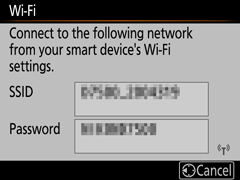
Smart device: Return to the smart device and tap [Next].
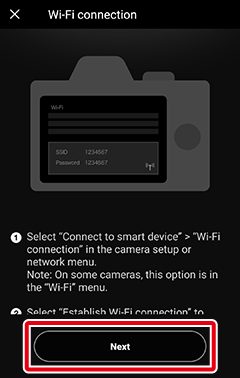
The instructions for smart device operations will be displayed.
Smart device: After reading the instructions, tap [Open the device settings app].

The smart device Wi‑Fi settings dialog will be displayed.
Smart device: Select the SSID displayed in Step 4 and enter the password.
Subsequent Connections
After you have entered the password once, you will no longer need to enter the password to connect. However, you will be required to enter the password again if it has been changed.
Smart device: Return to the SnapBridge app and wait for the smart device to connect.
Wi‑Fi AP mode options will be displayed once a connection is established.

The Connection Status Icon
An icon indicating the connection status is shown at the top right of the
 tab display. The statuses indicated by each icon are as follows.
tab display. The statuses indicated by each icon are as follows. : The SnapBridge app is in Wi-Fi AP Mode without a Wi-Fi connection to the camera.
: The SnapBridge app is in Wi-Fi AP Mode without a Wi-Fi connection to the camera. : The smart device is connected to the camera via Wi-Fi.
: The smart device is connected to the camera via Wi-Fi.
Cameras That Support the Wireless Mobile Utility
See here for more information.
Before Connecting via Wi-Fi
- Enable Wi-Fi on the smart device in advance. For details, see the documentation for your smart device.
- Be sure the batteries in the camera and smart device are fully charged to prevent unexpected loss of power.
- Check that there is space remaining on the camera memory card.
Wi-Fi AP Mode
The following are unavailable in Wi‑Fi AP mode:
- Automatic download of pictures taken
- Clock synchronization
- Embedding location data in pictures
- Manual location data download
- Connecting to NIKON IMAGE SPACE
- The [Nickname] option in the SnapBridge menu
- Bluetooth remote control
- Camera firmware download and transfer
Note: To use these features, exit Wi-Fi AP mode and pair the camera and smart device. See here to learn how to exit Wi-Fi AP mode.
Wi‑Fi AP Mode Not Available?
You cannot switch to Wi-Fi AP mode immediately after completing or interrupting the process of downloading pictures from the camera. After downloading pictures or interrupting transfer, wait at least three minutes before switching to Wi‑Fi AP mode.
Can’t Connect via Wi-Fi?
If you are unable to connect via Wi-Fi, follow the steps here to try again.
Backgrounding SnapBridge While Connected in Wi-Fi AP Mode
Sending the SnapBridge app to the background while certain cameras are connected in Wi-Fi AP mode will end the Wi-Fi connection (the app does, however, continue running in Wi-Fi AP mode). You will be prompted to re-establish the connection if you attempt to import pictures or perform other actions that require a Wi-Fi connection. Follow the on-screen instructions.
Nikon Z Mount Mirrorless Cameras
iOS device: Launch the SnapBridge app.
Tap [Connect to camera].

If you tapped [Skip] or Have Previously Launched the SnapBridge App
Tap the
 button in the
button in the  tab, select [Wi-Fi AP Mode Connection], and proceed to Step 3.
tab, select [Wi-Fi AP Mode Connection], and proceed to Step 3.

No [Wi-Fi AP Mode Connection] Option?
Check that the SnapBridge app is up to date. If you are using the latest version and this option is still missing, exit the app, check that the device is connected to the Internet, and then re-launch the app.
To exit the app, you must also terminate it in the background. See here for details on exiting the app.
iOS device: When prompted to select the camera type, tap the desired model, and then tap [Wi-Fi connection] when prompted.


- If the screen to select [Wi-Fi AP Mode] or [Wi-Fi STA Mode] is displayed, tap [Wi-Fi AP Mode].
Supported Camera Not Displayed?
Check that the SnapBridge app is up to date. If you are using the latest version and no option for your camera is displayed, exit the app, check that the device is connected to the Internet, and then re-launch the app.
To exit the app, you must also terminate it in the background. See here for details on exiting the app.
iOS device: When the instructions on camera operations are displayed, turn the camera on and proceed to the next step.
Do not tap [Next] yet.

Camera: In the camera menu, highlight [Wi-Fi connection] or [Wi-Fi connection (AP mode)], then press the J button.
Note: On some cameras, the option is found in [Connect to smart device].
Camera: Highlight [Establish Wi-Fi connection], press the J button, and proceed to the screen that displays the SSID and password.
The [Establish Wi-Fi connection] option is not displayed on some cameras. If the option is not displayed, enable the camera’s Wi-Fi communication function and proceed to the next step. For more information, see the documentation provided with the camera.
iOS device: Return to the smart device and tap [Next].
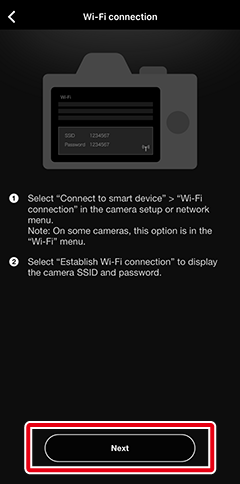
iOS device: After reading the instructions displayed by the smart device, tap [Open the device settings app].

The iOS Settings app will open.
iOS device: Tap [< Settings] to open the [Settings] screen, then tap [Wi-Fi] at the top.


iOS device: Select the camera SSID and enter the password to connect to the camera via Wi-Fi.

Note: The password can be viewed in the camera menus. For more information, see the documentation provided with the camera.
Note: After you have entered the password once, you will no longer need to enter the password to connect. However, you will be required to enter the password again if it has been changed.
iOS device: Return to the SnapBridge app and wait for the smart device to connect.
Wi‑Fi AP mode options will be displayed once a connection is established.
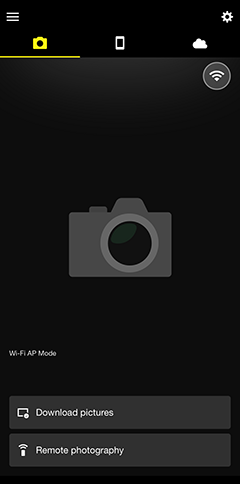
The Connection Status Icon
An icon indicating the connection status is shown at the top right of the
 tab display. The statuses indicated by each icon are as follows.
tab display. The statuses indicated by each icon are as follows. : The SnapBridge app is in Wi-Fi AP mode without a Wi-Fi connection to the camera.
: The SnapBridge app is in Wi-Fi AP mode without a Wi-Fi connection to the camera. : The smart device is connected to the camera via Wi-Fi.
: The smart device is connected to the camera via Wi-Fi.
Digital SLR Cameras That Support Wi-Fi AP Mode
For information on supported cameras, see here.
iOS device: Launch the SnapBridge app.
Tap [Skip].
- If you have launched SnapBridge before, proceed to Step 2.
- Tap [Connect to camera] to display the Bluetooth pairing screen. Tap the
 button at the top left corner to return to the previous display. See here for details on connecting via Bluetooth.
button at the top left corner to return to the previous display. See here for details on connecting via Bluetooth.

Tap the
 button in the
button in the  tab and select [Wi-Fi AP Mode Connection].
tab and select [Wi-Fi AP Mode Connection].

No [Wi-Fi AP Mode Connection] Option?
Check that the SnapBridge app is up to date. If you are using the latest version and this option is still missing, exit the app, check that the device is connected to the Internet, and then re-launch the app.
To exit the app, you must also terminate it in the background. See here for details on exiting the app.
iOS device: In the displayed dialog, tap [Wi-Fi connection] to display the camera operation instructions. Turn the camera on and proceed to the next step.
Do not tap [Next] yet.

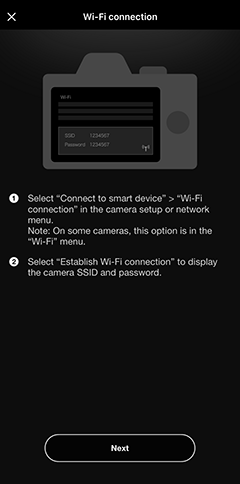
Camera: In the camera menus, select [Wi-Fi] > [Establish Wi-Fi connection], or select [Connect to smart device] > [Wi-Fi connection] > [Establish Wi-Fi connection], then press the J button. Proceed to the screen that displays the SSID and password.
Note: If the [Establish Wi-Fi connection] option is not displayed on a model that supports Wi-Fi AP mode, update the camera’s firmware to the latest version.

iOS device: Return to the smart device and tap [Next].

The instructions for smart device operations will be displayed.
iOS device: After reading the instructions, tap [Open the device settings app].

The iOS Settings app will open.
iOS device: Tap [< Settings] to open the [Settings] screen, then tap [Wi-Fi] at the top.


iOS device: Select the SSID displayed in Step 4 and enter the password.

Subsequent Connections
After you have entered the password once, you will no longer need to enter the password to connect. However, you will be required to enter the password again if it has been changed.
iOS device: Return to the SnapBridge app and wait for the smart device to connect.
Wi‑Fi AP mode options will be displayed once a connection is established.

The Connection Status Icon
An icon indicating the connection status is shown at the top right of the
 tab display. The statuses indicated by each icon are as follows.
tab display. The statuses indicated by each icon are as follows. : The SnapBridge app is in Wi-Fi AP mode without a Wi-Fi connection to the camera.
: The SnapBridge app is in Wi-Fi AP mode without a Wi-Fi connection to the camera. : The smart device is connected to the camera via Wi-Fi.
: The smart device is connected to the camera via Wi-Fi.
